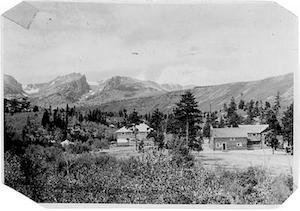
Estes Park, Your Base Camp For Rocky Mountain National Park
Whether you’re tempted by the alpine adventures, the incredible mountain scenery, or the real, varied wildlife, Rocky Mountain National Park is a hot spot for activity in all seasons. And, without lodging or supplies inside the park, Estes Park is your essential a base camp with everything you need to satisfy your needs and your desires.

High Alpine Paradise
The stats of Rocky are staggering:
• The park encompasses 265,873 acres.
• The top third of the park is alpine tundra.
• Trail Ridge Road (aka “the highway to the sky”) goes up to 12,183 feet in elevation!
• Rocky has 156 lakes and 450 miles of streams inside the park.
• There are more than 355 miles of hiking trails in the park.
• More than 60 peaks in the park rise above 12,000 feet in elevation!
For visitors, this all means that Rocky offers endless adventures. From hiking in your car on the famous Trail Ridge Road to summiting Colorado’s northern-most 14-er, Longs Peak, there is truly a mountain experience for every level of explorer – even those who don’t consider themselves explorers at all.
In Estes Park, merely minutes from the eastern entrance to Rocky, there are a plethora of outfitters, gear rental shops and licensed guides that can assist the novice to the expert. Grab the seasonal favorite fly for the best shot at luring the famed Cutthroat Trout. Pack up a picnic from a local deli for your wildlife watching. Book a tour or wilderness class, like with the Rocky Mountain Conservancy, the non-profit partner of the park. Get advice from a local on what trails to take for the best snowshoe conditions.
Leave Your Car Behind
To really experience the mountains, get away from the roads and go boating, horseback riding, fishing, hiking, cycling or climbing. Your escape might be as simple as spending an hour at an overlook, watching the wildlife in a meadow move around.
Taking just a few minutes to step away from your car can open up a whole new world. Just make sure you’re carrying a raincoat, sunscreen and water; the weather changes quickly in the mountains.
Rocky Mountain is a hiker’s paradise, with more than 350 miles of trails, from easy ambles to tough scrambles. One of the best hikes has to be the trail up 12,880-foot Mount Ida; the top is a bit of a scramble, but there’s little exposure and the view is phenomenal. You could also head down the Ute Trail, an easy hike along Tombstone Ridge, or take the more challenging 8.4-mile-roundtrip hike to Chasm Lake, with its outstanding views of The Diamond, the east face of Longs Peak.
Winter brings on another world in Rocky. With the quiet serenity of trekking fresh powder on snowshoe trails and the adrenaline thrill of backcountry skiing or split boarding, the mountains offer affordable winter fun for all ages and adventure levels. Exploration is made easy with local expert advice on proper gear, rental equipment and guided excursions out of Estes Park.
Creature Comforts
In the village of Estes Park, adventurers can refuel with all the modern amenities of home, only with a mountain flare. Rest up in cozy cabins, modern condos, full-service hotels and a variety of vacation homes.
Diners will find a wide variety, including BBQ, wild game, international cuisine and fresh trout. From upscale tables to casual fireside dining, tasty craft breweries to locally-made spirits, there is truly something for every palette.
Events and entertainment also abound in Estes with a full calendar of fun festivals, live music, performing arts and nightlife. With all of this activity right at the doorstep to the national park, there’s no reason not to make your visit a full-on Rocky Mountain vacation.
Savoring Rocky Mountain National Park’s Past While Looking To The Future
Not long into the development of the world's first national park system, ranchers in and around the valley floor of Estes Park, Colorado, came to an obvious realization: keeping guests happy was easier, and more profitable, than cattle.

Before Rocky Mountain became a national park, Abner Sprague ran a lodge in Moraine Park/NPS archives
That conclusion, reached about 1870 or so, cast the die for Estes Park as a welcoming and awe-inspiring destination. While ranching would remain part of the town's heritage, guiding travelers into the mountains of today's Rocky Mountain National Park, providing them with lodging and meals, and sharing their passions for the outdoors offered residents a better livelihood than raising cows.
"One of the early settlers, I think it was Abner Sprague, he said it made more sense for him to build cabins and charge people than to give meals away for free, because he had so many people who were visiting. They would just show up and ask him if he had an extra place to stay for the night," says Brian Hoerner, curator of collections at the Estes Park Museum.
So, after a couple of summers of such requests, it became clear to the early settlers of Estes Park that tourism would be easier and more profitable than ranching.
That has remained the case for more than 100 years as Estes Park has grown up alongside the national park, which was officially designated in 1915, or 55 years after Joel Estes put down roots with his son, Milton, in the valley that still holds his name.
Much has changed since then. The national park grew as resorts -- including now-forgotten lodges in Moraine and Horseshoe parks -- were removed by the National Park Service, the Big Thompson River was dammed to create Lake Estes, and homesteads on Elkhorn Avenue, Estes Park's main street, were slowly replaced by a unique variety of shops and restaurants.
Read the entire story here.

